Showing Spotlights 481 - 488 of 2880 in category All (newest first):
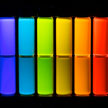 Researchers achieved a milestone in exploring biology using nanotechnology utilizing single-particle tracking to investigate the interaction between human T cells and individual fluorescent nanoparticles of semiconductor quantum dots (QDs). The researchers were able to deliver QDs into the cytosol of live T cells by decorating the nanoparticles with a unique cell-penetrating peptide. The study paves the way for improving drug delivery and immunotherapy using novel nanocarriers.
Researchers achieved a milestone in exploring biology using nanotechnology utilizing single-particle tracking to investigate the interaction between human T cells and individual fluorescent nanoparticles of semiconductor quantum dots (QDs). The researchers were able to deliver QDs into the cytosol of live T cells by decorating the nanoparticles with a unique cell-penetrating peptide. The study paves the way for improving drug delivery and immunotherapy using novel nanocarriers.
Mar 12th, 2021
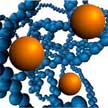 Various additives are added to plastics to either improve processability, change product properties or protect them against thermal, UV or light influences. In the case of a polymer nanocomposite, the additives have at least one dimension of less than 100 nm and can be found in the form of platelets, fibres or particles. They primarily serve to improve tensile strength, thermoformability, flame retardancy, optical and electrical properties, and the barrier properties of the plastic into which they are incorporated.
Various additives are added to plastics to either improve processability, change product properties or protect them against thermal, UV or light influences. In the case of a polymer nanocomposite, the additives have at least one dimension of less than 100 nm and can be found in the form of platelets, fibres or particles. They primarily serve to improve tensile strength, thermoformability, flame retardancy, optical and electrical properties, and the barrier properties of the plastic into which they are incorporated.
Mar 10th, 2021
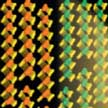 In general, there are three types of driving force for ion transport: electric field; mechanical pressure; and concentration gradient. Recently, light has been propsoed as a fourth. Now, researchers report the incorporation of a transition metal dichalcogenides based van der Waals multilayer heterostructure into nanofluidic materials, and demonstrate a new photo-induced active ion transport phenomenon. This will inspire a broad range of fundamental research and practical application for light-controlled ionic circuits, artificial photosynthesis, biomimetic energy conversion, and so on.
In general, there are three types of driving force for ion transport: electric field; mechanical pressure; and concentration gradient. Recently, light has been propsoed as a fourth. Now, researchers report the incorporation of a transition metal dichalcogenides based van der Waals multilayer heterostructure into nanofluidic materials, and demonstrate a new photo-induced active ion transport phenomenon. This will inspire a broad range of fundamental research and practical application for light-controlled ionic circuits, artificial photosynthesis, biomimetic energy conversion, and so on.
Mar 4th, 2021
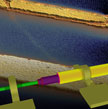 The properties ofvan der Waals heterostructures can be precisely controlled by twisting the stacked atomic layers, opening the way for the use of this unique degree of freedom for the nanoscale control of composite materials and nano-devices in future technologies. New work suggests that all 2D materials could also be rolled into their 1D counterparts and a plethora of function-designable 1D heterostructures could be realized. Unlike semiconductor nanowires or mono-elemental nanotubes, which are rolls of one type of material, these novel nanostructures would have very different, and customizable, properties.
The properties ofvan der Waals heterostructures can be precisely controlled by twisting the stacked atomic layers, opening the way for the use of this unique degree of freedom for the nanoscale control of composite materials and nano-devices in future technologies. New work suggests that all 2D materials could also be rolled into their 1D counterparts and a plethora of function-designable 1D heterostructures could be realized. Unlike semiconductor nanowires or mono-elemental nanotubes, which are rolls of one type of material, these novel nanostructures would have very different, and customizable, properties.
Mar 2nd, 2021
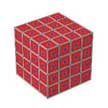 In another step towards engineered living materials, researchers combined living bacteria and 3D-printed materials to grow bionic mineralized composites with ordered microstructures. It provides an example of harnessing living bacteria to design self-growing materials and opens the door for a new class of engineering materials that can self-grow like living creatures. This manufacturing strategy can be easily extended by selectively controlling the activity of living organisms to synthesize unprecedented structural composites with ordered, hierarchical, and gradient microstructures.
In another step towards engineered living materials, researchers combined living bacteria and 3D-printed materials to grow bionic mineralized composites with ordered microstructures. It provides an example of harnessing living bacteria to design self-growing materials and opens the door for a new class of engineering materials that can self-grow like living creatures. This manufacturing strategy can be easily extended by selectively controlling the activity of living organisms to synthesize unprecedented structural composites with ordered, hierarchical, and gradient microstructures.
Feb 23rd, 2021
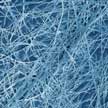 Researchers demonstrate composite materials with exceptional EMI shielding in the GHz and sub-THz frequency ranges while remaining electrically insulating. The composites use unusual fillers - chemically exfoliated bundles of quasi-one-dimensional van der Waals materials. The exceptional current conduction properties combined with extremely large aspect ratio of these composites couple strongly to high-frequency RF radiation while remaining electrically insulating in DC measurements.
Researchers demonstrate composite materials with exceptional EMI shielding in the GHz and sub-THz frequency ranges while remaining electrically insulating. The composites use unusual fillers - chemically exfoliated bundles of quasi-one-dimensional van der Waals materials. The exceptional current conduction properties combined with extremely large aspect ratio of these composites couple strongly to high-frequency RF radiation while remaining electrically insulating in DC measurements.
Feb 18th, 2021
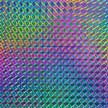 Beyond aesthetics, holograms on food - specifically, edible holograms - could be used to reduce packaging needs, for example, as information about nutritional content or labels could be printed directly onto the food item. To that end, researchers have developed a quick and low-cost fabrication method for producing holograms on edible substrates. They developed a direct laser interference pattering method to directly pattern one-dimensional nanostructures on corn syrup films.
Beyond aesthetics, holograms on food - specifically, edible holograms - could be used to reduce packaging needs, for example, as information about nutritional content or labels could be printed directly onto the food item. To that end, researchers have developed a quick and low-cost fabrication method for producing holograms on edible substrates. They developed a direct laser interference pattering method to directly pattern one-dimensional nanostructures on corn syrup films.
Feb 17th, 2021
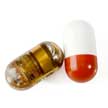 A major challenge in the development of implantable and ingestible biomedical electronic devices is the limited lifetime of their power sources. The energy requirements of these devices are highly dependent on their application and the complexity of the required electrical systems. The power unit, which is composed of one or more energy sources - batteries, energy-harvesting, and energy transfer - as well as power management circuits, supplies electrical energy to the whole system.
A major challenge in the development of implantable and ingestible biomedical electronic devices is the limited lifetime of their power sources. The energy requirements of these devices are highly dependent on their application and the complexity of the required electrical systems. The power unit, which is composed of one or more energy sources - batteries, energy-harvesting, and energy transfer - as well as power management circuits, supplies electrical energy to the whole system.
Feb 16th, 2021
 Researchers achieved a milestone in exploring biology using nanotechnology utilizing single-particle tracking to investigate the interaction between human T cells and individual fluorescent nanoparticles of semiconductor quantum dots (QDs). The researchers were able to deliver QDs into the cytosol of live T cells by decorating the nanoparticles with a unique cell-penetrating peptide. The study paves the way for improving drug delivery and immunotherapy using novel nanocarriers.
Researchers achieved a milestone in exploring biology using nanotechnology utilizing single-particle tracking to investigate the interaction between human T cells and individual fluorescent nanoparticles of semiconductor quantum dots (QDs). The researchers were able to deliver QDs into the cytosol of live T cells by decorating the nanoparticles with a unique cell-penetrating peptide. The study paves the way for improving drug delivery and immunotherapy using novel nanocarriers.
 Subscribe to our Nanotechnology Spotlight feed
Subscribe to our Nanotechnology Spotlight feed





